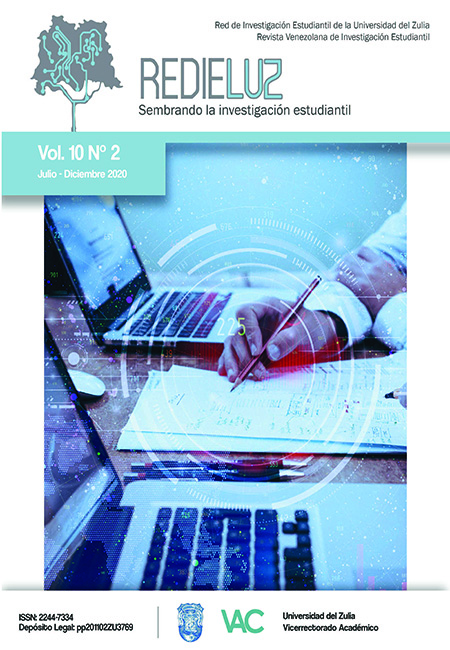Educational strategy to modify unhealthy lifestyles in malnutried young adults
Educational strategy to modify unhealthy lifestyles in malnutried young adults
Abstract
In the last decades, the increase in the figures of the prevalence of obese people worldwide is no-torious, related to the increase in chronic diseases such as diabetes mellitus and arterial hypertension. The objective of this research is to design an edu-cational strategy to modify unhealthy lifestyles in young adults with malnutrition. A descriptive, ob-servational, cross-sectional study was carried out in young adults with excess malnutrition, a survey was made to determine knowledge about healthy lifestyles, developing an educational strategy to mo-dify ignorance. Overweight prevailed with 57.7% in the group between 30 to 34 years (32%), the fema-le sex (60.8%) and secondary schooling (46.4%), the civil status free union (55.7% ), self-employment (49.5%), and mestizo ethnicity (67.0%). The knowle-dge of excess weight as a health problem represen-ted 91.8%. The lack of knowledge about healthy ea-ting was 78.4%, 59.8% were aware of food groups, 50.5% of physical exercises, and 58.8% of associa-ted diseases were greater. The preferred educatio-nal strategy was talks for 30 minutes (70.1%), once a week 43.3% and in the morning (87.6%).
Downloads
References
Blázquez E. (2016). Hormonas Gastrointestinales. Capítulo 78. Fisiología Humana. Access: Medicina. 2016 Disponible en: https://access-medicina.mhmedical.com/Content.aspx?booki-d=1858§ionid=134370207.
Duperly J. (2014). Obesidad. Un enfoque integral. Cuarta ed. Bogotá: Universidad del. Rosario.
ENSANUT. (2011-2013). Encuesta Nacional de Salud y Nutrición. ENSANUT Ecuador 2011-2013. INEC. Disponible en: http://www.ecuadorencifras.gob.ec//documentos/web-inec/Estadisticas_Sociales/ENSANUT/Presentacion%20de%20los%20principales%20%20resultados%20ENSA- NUT.pdf.
Gámbaro A., Raggio L., Dauber C., Ellis A., Toribio Z. (2011).Conocimientos nutricionales y frecuencia de consumo de alimentos: un estudio de caso. ALAN, 61(3): 308-315.
Jácome J. (2016). Mecanismos cerebrales de la obesidad; neurociencias para la actividad física. Red Internacional de neurociencias aplicadas a la actividad física y el deporte. Disponible en: https:// g-se.com/mecanismos-cerebrales-de-la-obesidad-neurociencias-para-la-actividad-fisica-bp-u57cfb26dece13.
López M. (2013). El estudio de la alimentación humana desde una perspectiva evolutiva y ecológica. Madrid: Universidad Autónoma de Madrid, Biología.
Ministerio de Salud Pública. (2013). Ecuador Mds- pd. www.msp.gob.ec.[Online].2013 [cited 2016 06 05. Availablehttp://instituciones.msp.gob.ec/ somossalud/images/documentos/guia/Manual_ MAIS-MSP12.12.12.pdf.Ministerio coordinador de desarrollo.
Moreira G. (2013). Libro blanco de la nutrición en España. Informativo. Madrid: Fundación Española de la Nutrición, Nutrición. Report No. 978-84- 938865-2-3.
Moreno G. (2012). Definición y clasificación de la obesidad. Revista Médica Clínica Las Condes, 23(2):124-8.
Moubarac D. (2015). Alimentos y bebidas ultraprocesados en América Latina: tendencias, efecto sobre la obesidad e implicaciones para las políticas públicas. Científico. Washintong DC.: Organización Panamericana de la Salud OPS, De- partamento de Enfermedades no Transmisibles y Salud Mental. Report No: 978-92-75-31864-5.
Organización Mundial de la Salud. (2014). Ginebra: Autoridad directiva y coordinadora de la acción sanitaria en el sistema de las Naciones Unidas; 2014. Disponible en: http://www.who.int/media-centre/factsheets/ fs311/es/
Organización Panamericana de la Salud, OPS/OMS (2007). La equidad en la mira: la salud pública en Ecuador durante las últimas décadas (Quito: OPS/MSP/CONASA). Principales causas de enfermedad y muerte. Quito. 2007. Pp: 74 – 8 6 . Disponible en: www.paho.org/ecu/index.php?op- tion=com_docman&task=doc...gid=5Alba-
Paredes A., Badilla Valero F., Johnson M. (2013). Nivel de conocimiento de actividad física de los estudiantes de cuarto año de enseñanza media humanístico – científica de los colegios Santo Tomás. Grado Académico de Licenciatura en Educación. Santiago – Chile, diciembre. Disponible en:http://repositorio.unab.cl/xmlui/bitstream/ handle/ria/1044/a110215_Alonso_C_Nivel_de_conocimiento_de_actividad_2013_Tesis.pdf?se- quence=1
Rodríguez H., Restrepo L., Deossa G. (2015) Conocimientos y prácticas sobre alimentación, salud y ejercicio en universitarios de Medellín-Colombia. Perspectivas en nutrición humana. Escuela de Nutrición y Dietética, Universidad de Antioquia. Medellín, Colombia, 17 (1): 36-54.
Vélez A. (2015). Prevalencia de obesidad en mujeres de 20 a 64 años en el centro de salud del cantón Chordeleg, en el periodo de enero 2015 a diciembre 2016. Licenciado en Nutrición y Dietética. Universidad de Cuenca.
Vergara A. (2013). Energía, alimentación y evolución. Rev Colomb Cir, 28 (97).
Copyright
Authors who publish in this journal agree to the following terms:
Authors retain copyright and grant the journal the right to be the first publication where the article is submitted, which is published under a Creative Commons Attribution License, which allows others to share the work upon acknowledgment of authorship of the work and initial publication in this journal.
Authors may separately enter into additional agreements for non-exclusive distribution of the version of the work published in the journal (e.g., placing it in an institutional repository or publishing it in a book), with an acknowledgement of its initial publication in this journal.
This work is licensed under the license:
Creative Commons Attribution-NonCommercial-ShareAlike 4.0 International (CC BY-NC-SA 4.0).



3.png)


_.jpg)

_(1).jpg)
1.jpg)





